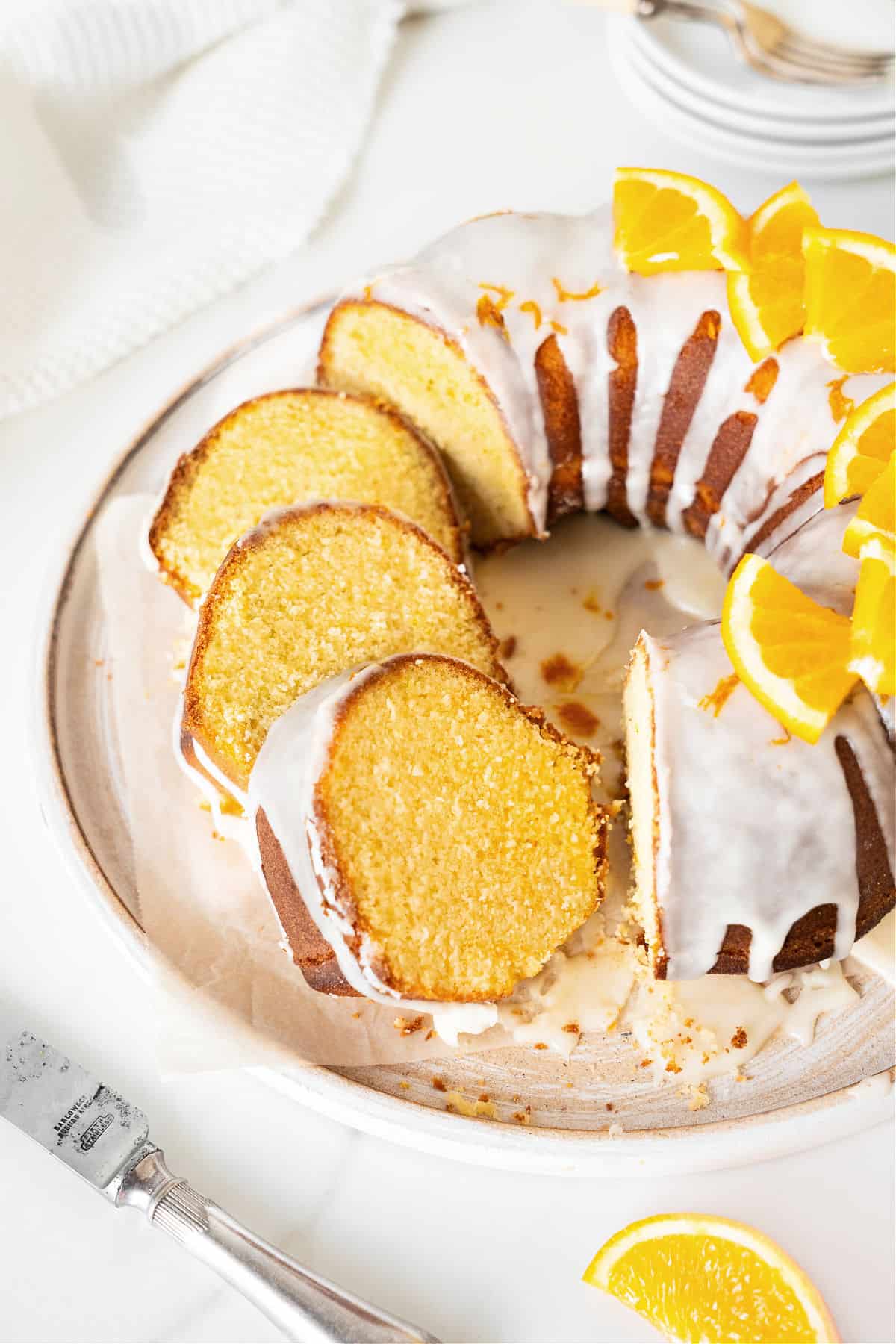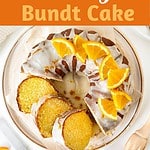This is a perfect, simple cake for orange lovers. The batter and glaze are bursting with flavor. The cake keeps well for several days and has a wonderful melt-in-your-mouth crumb, similar to a moist pound cake.

For orange lovers
In this little blog we love both bundt and orange cakes, so adding this recipe to the bundt and pound cakes archive was a no-brainer.
- Triple orange flavor: it has zest, fresh orange juice, and an orange glaze, so orange fans can swoon with every bite.
- It has a great crumb with a melt-in-your-mouth quality that's all you want in a pound cake.
- You can make it ahead. It keeps well for a few days and freezes wonderfully for a month or more.
FAQ
Yes, the difference is the pan they're baked in but not necessarily the type of batter. However, some simple or plain batters adapt better to a bundt cake pan than others.
Use a good recipe, such as this one, don't overbake it, and keep it covered with plastic wrap or in an airtight container for two days at room temperature after it's baked. Bundt cakes have a lot of batter coming in contact with the cake pan (due to its shape), so you must take it out as soon as the tester inserted comes out clean.

Ingredient Notes
Quantities are listed on the recipe card towards the end of this post. The Ingredients page has more details and lists the brands we use.
- Orange: use fresh juice and zest.
- Sour cream: use the regular type, full-fat sour cream. It adds richness and moisture.
- Baking powder: make sure it hasn't expired.
- Eggs: fresh, large.
- Milk: whole milk makes for a richer cake, but you can use 2%.
Preparing the bundt pan
If you bake bundt cakes often, you’ve likely had one stick to the pan. It’s frustrating—but preventable. Here are three reliable methods:
- Shortening and flour: Coat the pan thoroughly with soft shortening using your fingers or a brush, making sure to reach every corner, including the center tube. Dust with flour, rotating the pan to cover evenly, then tap out the excess over the sink.
- Cake goop (pan-release paste): Mix equal parts shortening, flour, and oil into a paste. Brush it onto the pan. Store leftovers in a jar—1 month at room temp or up to 3 months in the fridge. This is one of my favorite methods.
- Baking spray with flour: Only use baking spray that includes flour. Regular cooking spray isn’t enough and often leads to sticking. I rarely use this anymore.
The recipe matters too: When I find a bundt cake that releases cleanly, even without perfect prep, I hold onto it—it’s a keeper.
Steps to make an orange bundt cake
This is, in essence, a butter cake.
To cream the ingredients well, use a large bowl and an electric mixer or a stand mixer with the paddle attachment.
Scraping the sides is important throughout the beating and mixing process to ensure that the ingredients are well integrated.
Alternating wet ingredients and flour mixture: have ingredients at the temperatures specified in the recipe and add them in parts, starting and ending with dry ingredients (also called flour mixture). This will ensure that they all integrate correctly. If using a stand mixer, use it on low speed when you start incorporating the flour. Beating it too much makes for a tougher cake.

Sifting
It's important to sift the flour mixture to avoid clumps or impurities. And it helps with fluffiness.
You can sift them before or have the ingredients measured and sift them directly over the butter mixture (my choice).

Last mix
I highly recommend mixing the batter with a spatula at the end before pouring it into the prepared cake pan. Scrape the bottom to check for forgotten flour spots; integrate the batter well.
Vintage Kitchen Tip
After incorporating flour in a cake batter, we don't want to develop gluten, as it will toughen the baked cake. So mix *just* until it's all well incorporated but don't overbeat. I like to end mixing with a silicon spatula to ensure the ingredients are fully integrated.

Filling the pan
The bundt cake pan should be filled ⅔ to ¾ of its capacity, no more than that. This way, the batter has space to grow and bake well without overflowing or taking too long.

Baking
How long should you bake it? The baking time is in the recipe card, of course. But always remember that ovens and pans vary. Start checking when you're about ¾ of the time specified. The top will usually crack, and that's fine. When a cake tester or toothpick inserted in the center comes out clean, take it out and place it on a wire rack.
Orange glaze
A simple powdered sugar glaze with orange juice is the easiest way to dress up this cake.
How much liquid should you use?
It depends on how thick or thin you want the glaze to be.
Start with half the recipe's amount, mix well and add more as needed, half a teaspoon at a time, until you reach the desired consistency. It should resemble thick honey unless you want a very thin layer.
Can you make it in advance? Yes, you can. Keep it well covered in the fridge for about 5 days and give it a nice mix before using, as the sugar tends to form a thin layer.

Kitchen Notes
- Organization: read the recipe first and ensure you have ingredients at the correct temperature, utensils and equipment needed, and enough workspace. This will make the process so much easier.
- Baking time: consider that all ovens and pans are different, even if they look similar. The baking time in my recipes is as accurate as possible, but it might take you more or less time. You can use a thermometer (like the OXO oven thermometer) to check that your oven is at the right temperature. I recommend tracking how your oven works and what tiny details you might need to adjust.
- Removing it from the pan: this is a tricky answer as all pans are different. I leave it to cool down on a cooling rack for about 20 minutes and then shake the pan lightly to see if the cake loosens up on its own. If it doesn't, I carefully insert a smooth-bladed knife down the sides to see if there's something stuck there. Then, I shake it gently again. I then let it cool some more, maybe 15 minutes, and remove it carefully, putting the wire rack over the pan and inverting it.
- More orange flavor: The mix of juice and zest is a flavor powerhouse, but orange is mellower than lemon and other citrus. So, you can add ½ teaspoon of pure orange extract, as suggested in the recipe card below.
- Serving it: I think it's best eaten at room temperature. You can omit the glaze and sprinkle powdered sugar on top, or leave it plain cake and snack on it. If you want to dress it up, create a quick dessert by serving a slice with a dollop of whipped cream and strawberries or blackberries.
Related recipes you might like:
Before you go
If you made this recipe and loved it, you can comment below and leave a five-star ⭐️ review. Also, if you had issues, let me know so we can troubleshoot together.
You can also subscribe to our FREE email series 'Baking the Best' and our regular newsletter. Or follow and save my recipes on Pinterest.
As an Amazon Associate, I earn from qualifying purchases. Read my disclosure policy.

Orange Bundt Cake
Ingredients
Orange cake:
- 2 tablespoons shortening, soft, to grease the pan
- 2 tablespoons flour, to dust the pan
- 2 ½ cups all-purpose flour, or cake flour
- 2 ½ teaspoons baking powder
- ½ teaspoons salt
- ¾ cup unsalted butter, at room temperature
- 1 ¾ cup sugar
- 3 eggs, at room temperature
- 1 tablespoon orange zest
- ½ teaspoon vanilla extract
- ¼ teaspoon orange extract, optional but good for extra flavor (I use pure orange extract)
- ½ cup whole milk, at room temperature
- ¼ cup orange juice
- ½ cup sour cream, at room temperature
Orange glaze:
- 1 cup powdered sugar
- 2 tablespoons orange juice
- orange zest or slices to decorate, optional
Instructions
For the cake:
- Preheat oven to 350ºF (180°C).
- Grease a 10 or 12-cup bundt cake pan (26cm) with 2 tablespoons shortening, covering every angle, nook and cranny. Dust with 2 tablespoons flour, shaking off excess. Reserve.
- Sift 2 ½ cups all-purpose flour, 2 ½ teaspoons baking powder and ½ teaspoons salt. Set aside
- In a large bowl, beat ¾ cup unsalted butter until creamy. Slowly add 1 ¾ cup sugar and beat for 2 minutes.
- Add 3 eggs one at a time, beating well after each addition, and then beat for 2 more minutes.
- Add 1 tablespoon orange zest, ½ teaspoon vanilla extract and ¼ teaspoon orange extract (if using). Mix to integrate.
- Beginning and ending with dry ingredients, add them in 3 parts, alternating with ½ cup whole milk, ¼ cup orange juice and ½ cup sour cream in 2 parts.
- Pour batter into prepared pan, spreading evenly.
- Bake for about 45-50 minutes or until a cake tester or toothpick comes out clean. Depending on the type of pan and oven you use, it might take more. So always check and take baking times given in a recipe as a reference.
- Let cool 5-10 minutes and carefully invert onto a wire rack. Cool completely. At this point, you can wrap it in plastic for a day at room temperature, 3 days in the fridge or frozen for a month.
For the glaze:
- Mix 1 cup powdered sugar and 2 tablespoons orange juice in a small bowl until smooth and lump-free. Add more juice, half a teaspoon at a time, if you want it thinner.
- Drizzle over the cooled cake and let it drip down the sides. Use orange zest or slices to decorate. Wait until the glaze dries before cutting.






Rate and review this recipe